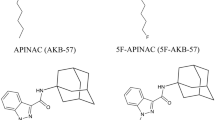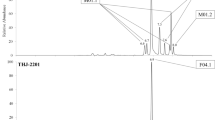Abstract
1-Pentyl-3-(4-methyl-1-naphthoyl)indole (JWH-122) is an agonist of the cannabinoid receptors CB1 and CB2. In this study, the phase I and phase II metabolisms of JWH-122 were investigated using two models. In vitro studies using incubations of JWH-122 with human liver microsomes were performed to obtain metabolites of the drug at the initial step; 11 classes of metabolites were found and analyzed by liquid chromatography–mass spectrometry (LC–MS) and liquid chromatography–tandem mass spectrometry (LC–MS–MS). Hydroxylation(s) on the naphthalene moiety and/or the indole moiety of the molecule took place as such or in combination with dehydrogenation or cleavage of the N-pentyl side chain. Furthermore, dihydrodiol metabolites were formed probably via epoxide formation on the naphthalene moiety, irrespective of the combination with hydroxylation(s). A metabolite carrying a carboxyl group on the N-pentyl side chain was also detected. As the second step of the study, in vivo experiments using chimeric mice were performed; the mice were orally administered JWH-122, and their urine samples were collected, subjected to enzymatic hydrolysis, and analyzed by LC–MS and LC–MS–MS. The urine samples without hydrolysis were also analyzed for their molecular formulae in the conjugated forms by LC–high resolution MS. The in vivo model using chimeric mice confirmed most metabolite classes and clarified the phase II metabolism of JWH-122. It was concluded that all metabolites formed in vivo were excreted conjugated as glucuronide or sulfate, with conjugation rates above 50 %.





Similar content being viewed by others
References
Zhang Q, Ma P, Cole RB, Wang G (2006) Identification of in vitro metabolites of JWH-015, an aminoalkylindole agonist for the peripheral cannabinoid receptor (CB2) by HPLC–MS/MS. Anal Bioanal Chem 386:1345–1355
EMCDDA (2009) Understanding the ‘Spice’ phenomenon. European Monitoring Centre for Drugs and Drug Addiction, Lisbon
Huffman JW, Szklennik PV, Almond A, Bushell K, Selley DE, He H, Cassidy MP, Wiley JL, Martin BR (2005) 1-Pentyl-3-phenylacetylindoles, a new class of cannabimimetic indoles. Bioorg Med Chem Lett 15:4110–4113
Lindigkeit R, Boehme A, Eiserloh I, Luebbecke M, Wiggermann M, Ernst L, Beuerle T (2009) Spice: a never ending story? Forensic Sci Int 191:58–63
Vardakou I, Pistos C, Spiliopoulou C (2010) Spice drugs as a new trend: mode of action, identification and legislation. Toxicol Lett 197:157–162
Nakajima J, Takahashi M, Seto T, Yoshida M, Kanai C, Suzuki J, Hamano T (2012) Identification and quantitation of two new naphthoylindole drugs-of-abuse, (1-(5-hydroxypentyl)-1H-indol-3-yl)(naphthalen-1-yl)methanone (AM-2202) and (1-(4-pentenyl)-1H-indol-3-yl)(naphthalen-1-yl)methanone, with other synthetic cannabinoids in unregulated “herbal” products circulated in the Tokyo area. Forensic Toxicol 30:33–44
Uchiyama N, Kawamura M, Kikura-Hanajiri R, Goda Y (2012) Identification of two new-type synthetic cannabinoids, N-(1-adamantyl)-1-pentyl-1H-indole-3-carboxamide (APICA) and N-(1-adamantyl)-1-pentyl-1H-indazole-3-carboxamide (APINACA), and detection of five synthetic cannabinoids, AM-1220, AM-2233, AM-1241, CB-13 (CRA-13), and AM-1248, as designer drugs in illegal products. Forensic Toxicol 30:114–125
Kneisel S, Bisel P, Brecht V, Broecker S, Müller M, Auwärter V (2012) Identification of the cannabimimetic AM-1220 and its azepane isomer (N-methylazepan-3-yl)-3-(1-naphthoyl)indole in a research chemical and several herbal mixtures. Forensic Toxicol 30:126–134
Jankovics P, Varadi A, Tolgyesi L, Lohner S, Nemeth-Palotas J, Balla J (2012) Detection and identification of the new potential synthetic cannabinoids 1-pentyl-3-(2-iodobenzoyl)indole and 1-pentyl-3-(1-adamantoyl)indole in seized bulk powders in Hungary. Forensic Sci Int 214:27–32
Westphal F, Sonnichsen FD, Thiemt S (2012) Identification of 1-butyl-3-(1-(4-methyl)naphthoyl)indole in a herbal mixture. Forensic Sci Int 215:8–13
EMCDDA (2011) Online sales of new psychoactive substances/‘legal highs’: summary of results from the 2011 multilingual snapshots. EMCDDA, Lisbon
Wintermeyer A, Moller I, Thevis M, Jubner M, Beike J, Rothschild MA, Bender K (2010) In vitro phase I metabolism of the synthetic cannabimimetic JWH-018. Anal Bioanal Chem 398:2141–2153
Sobolevskii TG, Prasolov IS, Rodchenkov GM (2011) Application of mass spectrometry to the structural identification of the metabolites of the synthetic cannabinoid JWH-018 and the determination of them in human urine. J Anal Chem 66:1314–1323
Ernst L, Schiebel HM, Theuring C, Lindigkeit R, Beuerle T (2011) Identification and characterization of JWH-122 used as new ingredient in “Spice-like” herbal incenses. Forensic Sci Int 208:e31–e35
Nakajima J, Takahashi M, Seto T, Kanai C, Suzuki J, Yoshida M, Hamano T (2011) Identification and quantitation of two benzoylindoles AM-694 and (4-methoxyphenyl)(1-pentyl-1H-indol-3-yl)methanone, and three cannabimimetic naphthoylindoles JWH-210, JWH-122, and JWH-019 as adulterants in illegal products obtained via the Internet. Forensic Toxicol 29:95–110
Peters FT, Meyer MR (2011) In vitro approaches to studying the metabolism of new psychoactive compounds. Drug Test Anal 3:483–495
Brandon EF, Raap CD, Meijerman I, Beijnen JH, Schellens JH (2003) An update on in vitro test methods in human hepatic drug biotransformation research: pros and cons. Toxicol Appl Pharmacol 189:233–246
Tingle MD, Helsby NA (2006) Can in vitro drug metabolism studies with human tissue replace in vivo animal studies? Environ Toxicol Pharmacol 21:184–190
Verstraete AG (2004) Detection times of drugs of abuse in blood, urine, and oral fluid. Ther Drug Monit 26:200–205
Lootens L, Meuleman P, Pozo OJ, Van Eenoo P, Leroux-Roels G, Delbeke FT (2009) uPA(+/+)–SCID mouse with humanized liver as a model for in vivo metabolism of exogenous steroids: methandienone as a case study. Clin Chem 55:1783–1793
Lootens L, Van Eenoo P, Meuleman P, Pozo OJ, Van Renterghem P, Leroux-Roels G, Delbeke FT (2009) Steroid metabolism in chimeric mice with humanized liver. Drug Test Anal 1:531–537
Strom SC, Davila J, Grompe M (2010) Chimeric mice with humanized liver: tools for the study of drug metabolism, excretion, and toxicity. Methods Mol Biol 640:491–509
Meuleman P, Libbrecht L, De Vos R, de Hemptinne B, Gevaert K, Vandekerckhove J, Roskams T, Leroux-Roels G (2005) Morphological and biochemical characterization of a human liver in a uPA–SCID mouse chimera. Hepatology 41:847–856
Grigoryev A, Kavanagh P, Melnik A (2012) The detection of the urinary metabolites of 3-[(adamantan-1-yl)carbonyl]-1-pentylindole (AB-001), a novel cannabimimetic, by gas chromatography–mass spectrometry. Drug Test Anal 4:519–524
Sekula K, Zuba D, Stanaszek R (2012) Identification of naphthoylindoles acting on cannabinoid receptors based on their fragmentation patterns under ESI-QTOFMS. J Mass Spectrom 47:632–643
Zhang Q, Ma P, Iszard M, Cole RB, Wang W, Wang G (2002) In vitro metabolism of R(+)-[2,3-dihydro-5-methyl-3-[(morpholinyl)methyl]pyrrolo [1,2,3-de]1,4-benzoxazinyl]-(1-naphthalenyl) methanone mesylate, a cannabinoid receptor agonist. Drug Metab Dispos 30:1077–1086
de Jager AD, Warner JV, Henman M, Ferguson W, Hall A (2012) LC–MS/MS method for the quantitation of metabolites of eight commonly-used synthetic cannabinoids in human urine—an Australian perspective. J Chromatogr B 897:22–31
Author information
Authors and Affiliations
Corresponding author
Rights and permissions
About this article
Cite this article
De Brabanter, N., Esposito, S., Geldof, L. et al. In vitro and in vivo metabolisms of 1-pentyl-3-(4-methyl-1-naphthoyl)indole (JWH-122). Forensic Toxicol 31, 212–222 (2013). https://doi.org/10.1007/s11419-013-0179-4
Received:
Accepted:
Published:
Issue Date:
DOI: https://doi.org/10.1007/s11419-013-0179-4




